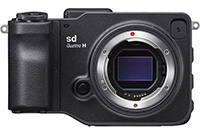 The Foveon sensor has intrigued me since the first Sigma DP cameras were introduced. The three layer design seems to be a much better idea than a bayer array. No matter how you finesse a bayer chip you are losing resolution and interpolating missing information. When you add in an anti-alias filter matters get worse. The whole bayer thing seems like an engineering song and dance.
The Foveon sensor has intrigued me since the first Sigma DP cameras were introduced. The three layer design seems to be a much better idea than a bayer array. No matter how you finesse a bayer chip you are losing resolution and interpolating missing information. When you add in an anti-alias filter matters get worse. The whole bayer thing seems like an engineering song and dance.
Unfortunately for Sigma the imaging sensor is just part of a camera package. You have to combine all the right functional components with a brilliant camera design to hit the mark. So far they have been unable to get the handling qualities of their cameras to a high enough standard. That may have changed with the last Quattro line of cameras but the design is unconventional to say the least. The latest Sigma cameras are more or less standard mirrorless ILC designs. That is a good thing.
Over the years I have seriously considered buying a Sigma compact camera. But reviews talking of handling issues, poor high ISO performance and slow focus have stopped me. Still I have a very strong desire to own a camera with a Foveon sensor.
I’ve never seen a full size un-retouched image file from a Sigma DP camera. They seem to be rare items. The best finished images I have seen are outstanding. They have qualities unlike anything I can achieve with my bayer sensor cameras. That is not to say that my skill level when processing Raw files is all that good.
This new interchangeable lens body design and APS-C/H chips sure seem to hit all the right notes. If they handle and perform as good as they look then this release could finally be the breakthrough that Sigma has been working toward for such a long time.



 Lately I’ve been reading articles about vision augmentation. That got me thinking about William Gibson Zeiss-Ikon eyes and other such fictions. Is there a future where journalists or average people can stream live video directly from their eyes? Will there be a time soon when we can store and reason using augmented visual information? Maybe but I have no knowledge of such things.
Lately I’ve been reading articles about vision augmentation. That got me thinking about William Gibson Zeiss-Ikon eyes and other such fictions. Is there a future where journalists or average people can stream live video directly from their eyes? Will there be a time soon when we can store and reason using augmented visual information? Maybe but I have no knowledge of such things.